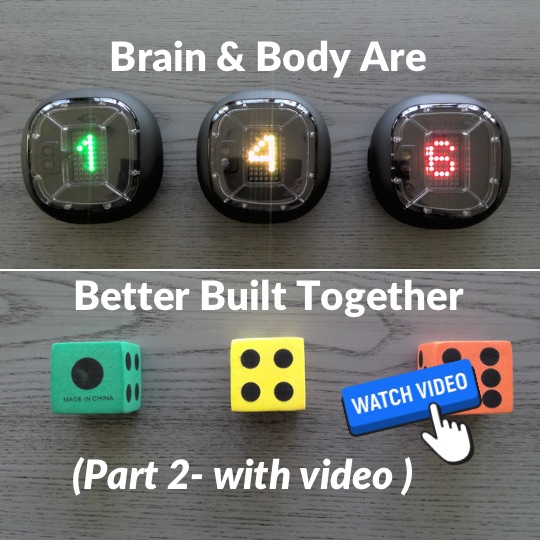Moving brain games deliver fitness for both body and brain. The difficulty of the physical and the cognitive task can be anything from easy to hard. Part 1 featured low-tech examples using foam dice and Part 2 – this one –features high tech examples using the ROX ProX pods with video.
High-Tech Examples – ROX ProX: The ProX Pods can display colors or colored letters, numbers, symbols. And they use sensors to detect movement just above the pods.
Descriptions of the exercises are below. Here is the video:
- Assign a single color to LEFT (e.g., green) and RIGHT (e.g., red). Use the corresponding hand (or foot) to deactivate the light.
- Option to add a 3rd color to the above that serves as a “switch” color. Meaning, if blue is the switch color, any blue light will be deactivated with the opposite side limb from the previous color. For example, if blue follows green, the right side would be used to deactivate blue, since green is designated as left in this series of examples.
- Same as #1 but now use hands and feet, alternating the limbs for a given color. Meaning, use left hand green, left foot for the next green, left hand for the next green, and so on. This will challenge short-term memory due to the need to remember if the next red or green light should be deactivated with the hand or foot.
- Deactivate number lights in order from lowest to highest.
- Deactivate letter lights with the corresponding limb while verbally calling out the name of something in a predetermined category that starts with that letter. Sample categories can include movies, foods, animals, musical artists, proper names, etc.
- Putting it all together: Mix of letters, numbers, and colors. Deactivate lights with corresponding limb. When letters display, follow instructions for verbal callouts in the previous exercise. When numbers display, add it to the last number shown.
This one is too hard. This one is too easy. This one is just right.
This final option requires remembering the left/right colors, the running number total, and searching memory for an appropriate category word that starts with the correct letter. In other words, it is the hardest from a cognitive perspective. But that doesn’t mean it is the best. Going too hard too early creates frustration from poor performance.
The right level of cognitive challenge features occasional mistakes with mostly correct performance. And just like with physical fitness, over time the challenge can be progressed as appropriate.
Brain training is good for the brain, as is exercise. Blending body and brain training amplifies the brain benefits of both. Low-tech or high-tech options are available so that just about anyone can derive the benefits of blended training.

